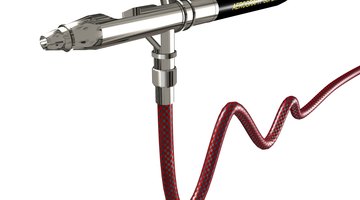How to Paint Metal
Table of Contents
Metal is a tricky surface to paint unless you prepare it first. Half the battle of a good metal paint job begins with the proper preparation of its surface. Whether it’s ferrous or galvanized metal, each surface type has specific steps you must complete to prepare it for the paint.

Most metals require a pretreatment before you can get the paint to stick.
Rusted Metals
Ferrous metals rust when exposed to water, moisture or humidity. Before you can paint ferrous metals, remove the surface rust. Apply a wire brush or use a power drill with a brush attachment to get rid of all the rust. After removing the rust, wipe the piece down with a damp cloth, followed by a dry cloth. Do not let metal cleaned of rust sit overnight, or it could develop a flash coat of rust.
Galvanized Metals
Metals that have been galvanized have a special coating that prevents rust from forming. But new galvanized metal requires cleaning to remove the oily residue or coating left by the manufacturing process. Older galvanized metal may have an oxidation coat requiring removal before painting. Clean galvanized metal with a detergent-based cleaning solution; rinse and dry. For oxidation, use a wire scrub brush or sandpaper to remove the oxidation. You can also chemically etch the surface of metals for it to accept paint. Sand with fine-grit, wet-dry sandpaper for smooth surfaces.
Primer Coat
For smooth finishes, don't scratch up or etch the metal before painting; instead, use a primer coat designed specifically for metal after you clean or remove the rust. If you are using spray paints, hold the can upright 10 to 12 inches from the piece and work in a side-to-side motion at a consistent speed. If you hold the can too close, the primer can run. Too far back doesn’t offer enough coverage. Practice on a scrap piece of metal to get the feel of painting with a spray can. You can also use a paint sprayer or airbrush in a similar fashion, although the type of paint used determines how far away to hold the sprayer. Let the primer coat dry thoroughly.
Paint Choices
For painting craft metals, such as metal models, garden or landscaping decor, kid’s metal toys, jewelry or decorative pieces, you can use a variety of spray paints designed for metal with rust inhibitors for outside pieces or enamel and acrylic paints for inside items. Choose the paint that best works with your application. If you’re using a paint sprayer or airbrush, you might have to dilute the paint with paint thinner for enamel or oil-based paints, or with water for some acrylics.
Paint the Surface
Work from side to side to cover the metal with even strokes with a can of spray paint or paint applied from a sprayer or airbrush. For spray paints, hold the can 10 to 12 inches from the surface, moving parallel to the surface at a consistent speed as you paint, dropping down to cover the next row with a bit of overlap. Paint sprayers and airbrushes require several thin coats sprayed parallel to the surface of the item for good coverage. Adjust the pressure settings and select the appropriate tips as advised by the manufacturer for the specific paints used. To unclog a paint sprayer, hold it upside-down and spray for a few seconds.
References
Resources
Writer Bio
As a native Californian, artist, journalist and published author, Laurie Brenner began writing professionally in 1975. She has written for newspapers, magazines, online publications and sites. Brenner graduated from San Diego's Coleman College.
Photo Credits
- Daneel/iStock/Getty Images
- Daneel/iStock/Getty Images
More Articles


